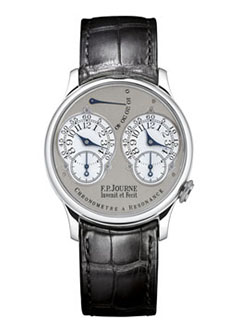Not everyone can become one of the best watchmakers of his time. One becomes the best, little by little, by emerging from a long legacy. And it is not merely by chance that, over the centuries, lineages, as bright as they are mysterious, are established among watchmakers driven by the same passion.
Antide Janvier built his first moving sphere in wood at the age of 15, a feat that two years later received recognition from the Science Academy of Besançon. Young François-Paul started making his first tourbillon watch at the age of 20 and when he was 22 years old he designed a first planetarium.
Amongst the numerous masterpieces made by Antide Janvier, complicated astronomic clocks, planetarium and other remarkable spheres with equations, we are here reminded in a regulator of his mastery of physical resonance. This natural phenomenon is currently perpetuated exclusively by F.P. Journe, using this difficult and delicate technique with a modern conception: that of a mechanical wristwatch that was made to provide the greatest precision.
Was it possible to condense a large double pendulum into the small space available in a wristwatch? Despite understandable doubts, F.P. Journe nevertheless decided to engage in this this modern quest to reach an extreme degree of precision in time measurement.
For François-Paul Journe, as for Antide Janvier, it took several years to meet this apparently impossible challenge. François-Paul Journe searched, calculated, pondered, gave up... and then began all over again, calculating and designing until he truly entered into intellectual resonance with Antide Janvier. Only then did he begin to understand the principle and become able to follow the same path, think the same way. The first “resonance” wristwatch was commercialized as a world premiere in the year 2000.
François-Paul Journe devised, developed and built this movement to meet the demands of actual wear on the wrist and thereby provide chronometric performance driven to extremes. The result is a watch representing one of the wildest challenges in the field of mechanical watches! Each of the two balances alternately serves as exciter and resonator. When the two balances are in movement, they enter into harmony thanks to the resonance phenomenon and begin to beat naturally in opposition. The two balances then support each other, giving more inertia to their movement.
This is possible only if the difference of the frequency from one to the other does not exceed five seconds per day cumulated on six positions. Their setting is an extremely delicate task.
Whereas an external disturbing movement affects the running of a traditional mechanical watch, the same disturbance, for the Chronomètre à Resonance, produces an effect that accelerates one of the balances as much as it slows the other down. Little by little, the two balances come back towards each other to find their point of harmony, thus eliminating the disturbance. This mechanism revolutionizes established standards and offers a degree of precision that had never previously been achieved in a mechanical wristwatch.
In 2004, F.P. Journe finally made another dream come true by manufacturing its haute horology movement in precious metal, 18K rose gold. The Chronomètre à Résonance thus features for the first time an 18K rose gold movement. A specificity that would from then on apply to all the precision chronometers of the brand.
April 19, 2018


 News
News 